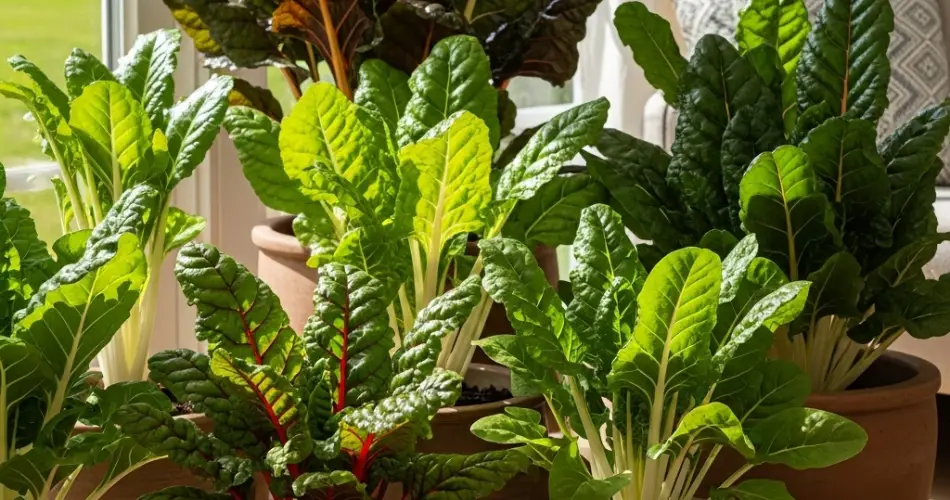If you’re looking to grow a leafy green that’s both beautiful and nutritious, Swiss chard is an excellent choice—especially for those with limited space. Its colorful stalks and lush leaves bring life to small balconies, patios, windowsills, and even indoor kitchen corners. Best of all, Swiss chard grows remarkably well in small decorative pots, turning your greens into a stylish and practical home feature.
Whether you want a splash of color or a constant supply of vitamin-rich leaves, this guide will walk you through how to grow Swiss chard successfully in small containers.
Why Swiss Chard is Great for Small Pots
Swiss chard is a versatile and low-maintenance vegetable that adapts well to container gardening. It’s not only grown for its tasty leaves, but also for its ornamental value.
Here’s why it’s ideal for decorative pots:
-
Compact and upright growth – Perfect for small vertical spaces.
-
Vibrant appearance – Red, yellow, pink, and white stems look stunning in decorative planters.
-
Cold and heat tolerant – Grows across seasons with minimal fuss.
-
Continuous harvest – Keeps producing leaves for several months with proper care.
-
Nutrient-packed – Loaded with vitamins A, C, and K, iron, magnesium, and fiber.
It’s the perfect plant to bridge beauty and function in your home garden setup.
Choosing a Variety for Containers
Not all Swiss chard varieties are created equal, especially when it comes to container growing. While most types will grow in a pot, some are more compact and visually appealing.
Recommended varieties:
-
Bright Lights – A rainbow-colored mix of red, orange, pink, and white stalks; ideal for decorative pots.
-
Rhubarb Chard (Ruby Red) – Dark green leaves with deep red veins and stalks.
-
Fordhook Giant – Large white-stemmed chard with big leaves, better suited for slightly larger pots.
Choose smaller or ornamental varieties for decorative containers, especially if space is tight or you want an eye-catching display.
Picking the Right Decorative Pot
Your choice of container matters just as much as the plant. Decorative pots can range from ceramic and terracotta to painted tin, woven baskets with liners, or recycled household items with holes drilled for drainage.
Container requirements:
-
Depth: At least 8–10 inches
-
Width: One plant per 8–10-inch pot, or several plants in a larger container
-
Drainage: Must have holes to prevent root rot
Decorative pots often lack proper drainage, so if necessary, add a layer of small stones at the bottom or drill holes yourself.
Preparing the Potting Mix
Swiss chard prefers loose, nutrient-rich, and well-draining soil. The right mix will provide essential minerals and retain enough moisture without becoming soggy.
Ideal soil blend:
-
2 parts all-purpose organic potting mix
-
1 part compost or aged manure
-
Optional: 1 part perlite or coconut coir for better drainage
Before planting, pre-moisten the soil to make sure it’s evenly damp.
Planting Swiss Chard in Decorative Pots
You can start Swiss chard from seeds or buy young seedlings for a quicker harvest. For small pots, spacing is key—avoid overcrowding to let the plants grow properly.
To plant seeds:
-
Sow seeds ½ inch deep and 2–3 inches apart.
-
Water gently and keep the soil moist.
-
Once seedlings grow 2–3 inches tall, thin them out to allow 6–8 inches between plants.
For seedlings:
-
Gently place each one in the pot at the same soil depth as their nursery container.
-
Space them about 6 inches apart.
-
Firm the soil around each plant and water thoroughly.
Sunlight and Climate Needs
Swiss chard enjoys sunlight but can tolerate partial shade—making it flexible for many locations.
-
Sunlight: 5–7 hours of sunlight per day is ideal.
-
Temperature: Thrives in 50°F to 85°F (10°C to 29°C).
-
Seasons: Can be grown in both cool and warm weather. In hot climates, some afternoon shade is beneficial.
Place your decorative pots in areas where they get gentle morning sun and protection from harsh afternoon rays.
Watering and Feeding
Container-grown Swiss chard dries out faster than garden-grown plants, so consistent watering is essential.
Tips:
-
Water when the top inch of soil feels dry.
-
Avoid letting the soil get soggy—ensure drainage is working well.
-
Add mulch or small pebbles on the soil surface to retain moisture and enhance pot appearance.
Feeding:
-
Mix in compost at planting time.
-
Use a balanced liquid fertilizer every 2–3 weeks to encourage leafy growth.
Harvesting Swiss Chard from Pots
You can start harvesting Swiss chard as soon as the leaves reach about 6 inches in length.
How to harvest:
-
Snip or gently pull outer leaves from the base, leaving the center to continue growing.
-
Avoid cutting more than one-third of the plant at a time.
-
Harvest regularly to encourage fresh new leaves.
You’ll enjoy fresh greens for several months from just one pot.
Common Problems and How to Prevent Them
-
Yellowing leaves: Usually due to overwatering or poor drainage—check the pot’s drainage holes.
-
Pests: Aphids and leaf miners are common; use neem oil spray or remove pests by hand.
-
Bolting: Happens in very hot weather—harvest early and replant in cooler seasons if needed.
Routine care and observation will help you keep your plants healthy and productive.
Final Thoughts
Growing Swiss chard in small decorative pots is a fantastic way to combine gardening with home aesthetics. It brings beauty, freshness, and nutrition right to your windowsill, balcony, or front porch—without needing a full garden.
With just a bit of care and the right setup, you can enjoy a rainbow of leafy greens that not only taste delicious but look stunning, too. Whether you’re gardening for food or flair, Swiss chard is a top choice for small-space growers.



